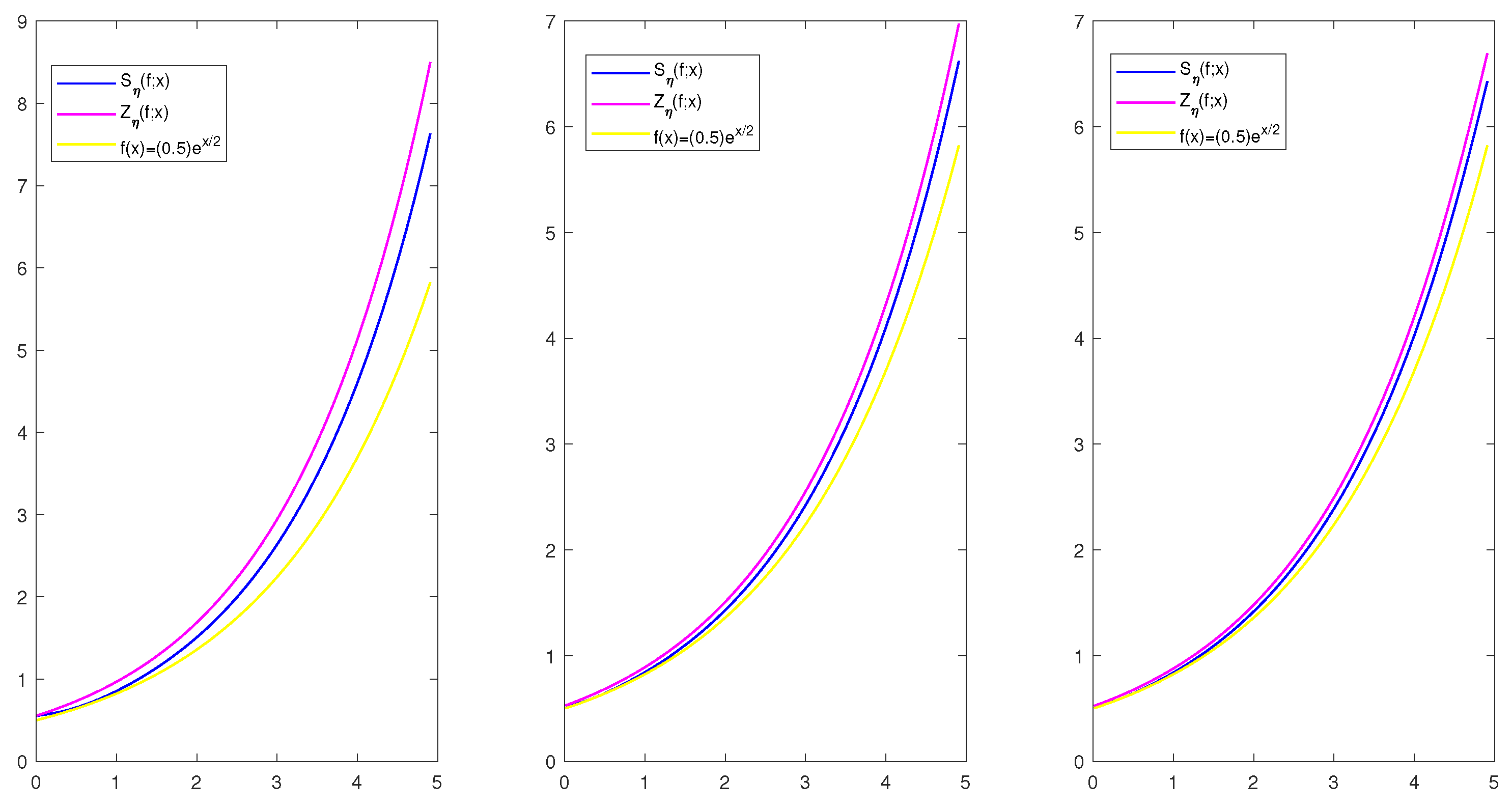Szász–Durrmeyer Operators Involving Confluent Appell Polynomials
Abstract
:1. Introduction
- (i)
- is a confluent sequence of Appell polynomials.
- (ii)
- ’s generating function is granted by
2. Approximation Properties
3. Rate of Convergence
4. Special Cases
4.1. Approximation Properties for
4.2. Approximation Properties for
5. Graphical Analysis
6. Conclusions
Author Contributions
Funding
Institutional Review Board Statement
Informed Consent Statement
Data Availability Statement
Acknowledgments
Conflicts of Interest
References
- Appell, P. Sur une classe de polynomes. Ann. Sci. Ec. Norm. Suppl. 1880, 9, 119–144. [Google Scholar] [CrossRef]
- Rainville, E.D. Special Functions; The Macmillan Company: New York, NY, USA, 1960. [Google Scholar]
- Jakimovski, A.; Leviatan, D. Generalized Szász operators for the approximation in the finite interval. Mathematica 1969, 11, 97–103. [Google Scholar]
- Mazhar, S.; Totik, V. Approximation by modified Szász operators. Acta Sci. Math. 1985, 49, 257–269. [Google Scholar]
- Özarslan, M.A.; Çekim, B. Confluent Appell polynomials. J. Comput. Appl. Math. 2023, 424, 114984. [Google Scholar] [CrossRef]
- Liu, Y.J.; Cheng, W.T.; Zhang, W.H.; Ye, P.X. Approximation Properties of the Blending-Type Bernstein–Durrmeyer Operators. Axioms 2022, 12, 5. [Google Scholar] [CrossRef]
- El-Deeb, S.M.; Murugusundaramoorthy, G.; Vijaya, K.; Alburaikan, A. Pascu-Rønning Type Meromorphic Functions Based on Sălăgean-Erdély–Kober Operator. Axioms 2023, 12, 380. [Google Scholar] [CrossRef]
- Sabancıgil, P. Genuine q-Stancu-Bernstein–Durrmeyer Operators. Symmetry 2023, 15, 437. [Google Scholar] [CrossRef]
- Alotaibi, A. On the Approximation by Bivariate Szász–Jakimovski–Leviatan-Type Operators of Unbounded Sequences of Positive Numbers. Mathematics 2023, 11, 1009. [Google Scholar] [CrossRef]
- Khan, M.F.; Al-Shaikh, S.B.; Abubaker, A.A.; Matarneh, K. New Applications of Faber Polynomials and q-Fractional Calculus for a New Subclass of m-Fold Symmetric bi-Close-to-Convex Functions. Axioms 2023, 12, 600. [Google Scholar] [CrossRef]
- Chandragiri, S.; Shishkina, O.A. Generalized Bernoulli Numbers and Polynomials in the Context of the Clifford Analysis. J. Sib. Fed. Univ. Math. Phys. 2018, 11, 127–136. [Google Scholar]
- Leinartas, E.K.; Shishkina, O.A. The Discrete Analog of the Newton-Leibniz Formula in the Problem of Summation over Simplex Lattice Points. J. Sib. Fed. Univ. Math. Phys. 2019, 12, 503–508. [Google Scholar] [CrossRef]
- Korovkin, P.P. On convergence of linear operators in the space of continuous functions. Dokl. Akad. Nauk. SSSR 1953, 90, 961–964. (In Russian) [Google Scholar]
- Devore, R.A.; Lorentz, G.G. Constructive Approximation; Springer: Berlin, Germany, 1993. [Google Scholar]
- Ciupa, A. A class of integral Favard-Szász type operators. Stud. Univ. Babeş-Bolyai Math. 1995, 40, 39–47. [Google Scholar]

| 10 | 0.00204334 |
| 0.00138627 | |
| 0.00089236 | |
| 0.00054954 | |
| 0.00032734 | |
| 0.00019062 | |
| 0.00010942 |
Disclaimer/Publisher’s Note: The statements, opinions and data contained in all publications are solely those of the individual author(s) and contributor(s) and not of MDPI and/or the editor(s). MDPI and/or the editor(s) disclaim responsibility for any injury to people or property resulting from any ideas, methods, instructions or products referred to in the content. |
© 2024 by the authors. Licensee MDPI, Basel, Switzerland. This article is an open access article distributed under the terms and conditions of the Creative Commons Attribution (CC BY) license (https://creativecommons.org/licenses/by/4.0/).
Share and Cite
Kanat, K.; Erdal, S. Szász–Durrmeyer Operators Involving Confluent Appell Polynomials. Axioms 2024, 13, 135. https://doi.org/10.3390/axioms13030135
Kanat K, Erdal S. Szász–Durrmeyer Operators Involving Confluent Appell Polynomials. Axioms. 2024; 13(3):135. https://doi.org/10.3390/axioms13030135
Chicago/Turabian StyleKanat, Kadir, and Selin Erdal. 2024. "Szász–Durrmeyer Operators Involving Confluent Appell Polynomials" Axioms 13, no. 3: 135. https://doi.org/10.3390/axioms13030135






